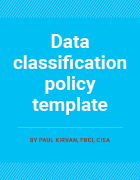
pathdoc - stock.adobe.com
How to write a data classification policy, with template
Data classification policies help organizations categorize, secure and manage sensitive information while maintaining regulatory compliance and reducing breach risks.
Organizations churn out vast amounts of data every day. Those without defined data classification processes risk not knowing where their data resides or if it's properly protected.
Let's examine how to create a data classification policy that ensures data is described, located, secured and complies with domestic and global data protection standards and regulations. Then, use our free template to create a policy for your company.
What is data classification?
Data classification involves categorizing information by its sensitivity, importance and other criteria. It helps make data easier to retrieve, sort and store, and ensures the proper security protections are in place.
Data classification is an important part of data lifecycle management, providing the framework for categorizing or grouping data objects. It takes time to develop a comprehensive data classification program. Once established, however, the process helps organizations comply with their own data handling guidelines as well as local, state and federal compliance regulations, such as HIPAA and GDPR.
A data classification policy gives companies a roadmap that illustrates how to sort data of all types -- structured and unstructured. Structured data -- information that's organized and searchable -- is typically indexed using data classification metrics. Unstructured data -- information such as videos, images and emails -- is not as easily organized.
Data classification makes data more usable and easier to search or query. It also identifies duplicate copies of data, which helps improve data storage and data security measures.
Benefits of a data classification policy
The following are some of the benefits of a data classification policy. As noted, this is an important component of a data management program.
- Securing and protecting sensitive information. Data classification helps prevent unauthorized access and use by assigning specific categories and other metrics to sensitive data, such as personally identifiable information.
- Reducing the risk of a data breach. Data classification and other techniques make security measures, such as MFA, possible, thus reducing the risk of data breaches and unauthorized access.
- Complying with regulations. A policy helps regulated organizations in the public and private sectors demonstrate compliance with regulatory requirements, such as GDPR, HIPAA and CCPA.
- Enhancing data management. Data classification is an important piece of an overall data management program, helping facilitate the location, retrieval and security of data.
- Allocating resources effectively. A data classification policy ensures that time, money and technology resources are allocated effectively by securing high-priority data.
- Enhancing decision-making. Data classification makes it easier for organizations to deliver informed decisions about storing, sharing or deleting data.
- Boosting employee awareness. Explaining why data classification is important enables employees to understand the value of data protection and how to handle different types of information responsibly.
- Bolstering security. Data classification aids in addressing and mitigating data-related risks, thus enhancing the organization's overall security posture.
Components of a data classification policy
Data classification policies differ by the type of industry, compliance requirements and other factors, but they generally all include the following:
- Purpose and scope. Defines what the policy addresses, to whom it applies, and the types of data classified.
- Definitions. Explanations of key terms.
- Types of data to be classified. Defines what kinds of data are subject to classification.
- Levels of classification. Specifies how to label data, for example, private, public, confidential or secret.
- Roles and responsibilities. Defines who handles the classification process and who enforces the policy.
- How to handle classified data. Explains how data classification applies to data storage, sharing, disposal, access, encryption and other protective measures.
- Compliance requirements. Specifies the standards, regulations, legislation and other statutes to which the data classification policy must comply.
- Legal requirements. Specifies legal requirements the policy must address.
- Employee awareness and training. Provides guidance on how to educate employees on adhering to the policy.
- Policy monitoring and enforcement. Explains how to monitor compliance with the policy and how to identify violations.
- Penalties for noncompliance. Describes penalties for nonconformance with the policy, for example, reprimand and termination.
- Policy review and updating. Provides guidelines on how often to review and update the policy and defines how the policy will be continuously improved.
- References and appendices. Any additional content that supports the policy.
Best practices for writing a data classification policy
Before developing a data classification policy, determine if there are existing policies in place to use as a foundation. Examine those policies to find an appropriate corporate format and structure. An existing data management policy, for example, could provide a useful starting point.
When writing or updating a policy, consider the following best practices:
- Include senior management and others in the process. Get senior management approval when launching a data classification policy project. Consider involving other stakeholders and key subject matter expert employees as needed.
- Understand the data to be classified. Conduct an inventory to identify data that needs to be classified. Determine existing data types, where data is stored and how data is used.
- Establish data categories. Use categories that make sense and are consistent with how the organization operates, such as public, internal, confidential and highly confidential. Make sure these categories comply with required statutes.
- Seek support from across the business. Contact departments, such as business units, legal, HR, compliance and IT, for details on their data to make sure the policy addresses the company's diverse needs and responsibilities.
- Define roles and responsibilities. Specify who will manage the data classification process. This includes who classifies data, maintains its accuracy and safeguards policy compliance.
- Define security requirements. Link security requirements to each data classification category. For example, highly sensitive data requires encryption and strict access controls.
- Schedule employee awareness and education. Employees must be aware of the policy and know how to use it properly in their daily tasks.
- Design it to be flexible and scalable. Design and format the policy so that its specifications are easily understood, easy to implement and adaptable as the organization evolves.
- Ensure regulatory compliance. Once the requisite standards and regulations have been identified, write the policy to clearly comply with the statutes.
- Review, update and continually improve. Establish a schedule to periodically review and update the policy to ensure it remains effective and relevant as applicable to business operations, regulatory compliance, security threats, changes in technology and legal requirements. This is a key part of the continuous improvement process.
- Document items. The policy is an important business document and plays an essential role in audits. The policy and any procedures developed from it should be fully documented. Consider including guidelines to assist employees in correctly classifying and handling data.
How to create a data classification policy
Use the following steps to write a data classification policy:
- Define scope and purpose. Define the policy's fundamental aspects and address data security, regulatory compliance and operational improvement.
- Identify the data. Conduct an inventory of data, then locate where data is stored, how it is used and who can access it.
- Set classification levels. Establish categories, such as public, internal use only and confidential, and define criteria for assigning data to each level, such as sensitivity or legal requirements.
- Roles and responsibilities. Identify who will manage the classification process, maintain data integrity, launch security safeguards and ensure policy compliance.
- Define data handling guidelines. Specify how to handle data at each level. This can include procedures for access controls, authentication, encryption, data storage and disposal, and rules for transferring and sharing data, both internally and externally.
- Manage compliance. Identify the required standards, regulations and other statutes and how the policy should comply with them.
- Employee awareness and training. Establish an awareness program to describe the classification process and training to ensure employees understand the policy, classification levels and how to handle data properly.
- Document the policy. Use existing policies or templates as a foundation and compile relevant policy attributes into a single document that includes procedures, roles and responsibilities and consequences for noncompliance.
- Launch the policy with monitoring and enforcement. Initiate the policy and procedures designed to monitor compliance, document noncompliance occurrences and outline consequences for policy violations.
- Policy review and updating. Establish a schedule for reviewing the policy to accommodate regulatory changes, technology developments, changes in the business and emerging security threats or other challenges.
Examples of data classification policies by industry and vertical
Data classification policies address data, to be sure, but the underlying criteria within policies vary based on the type of industry or vertical market. The following are examples of how this occurs in several different markets:
- Healthcare. Addresses the protection of sensitive patient information, such as medical records and billing data. Data classifications might include protected health information, internal use data and public data. Policies must be designed to comply with regulations such as HIPAA.
- Banking and finance. Safeguards customer information, transaction details and proprietary financial models and algorithms. Compliance with regulations such as GDPR, PCI DSS, Sarbanes-Oxley Act and U.S. Securities and Exchange Commission mandates is essential.
- Government. Classifies data according to its security and sensitivity, especially as applicable to national security. Categories include confidential, secret and top secret. At the federal level, data classification is directed by the Federal Information Processing Standard, overseen by NIST.
- Retail and e-commerce. Covers customer details, payment information, supply chain details and other factors. Compliance with federal and state-level consumer privacy laws is key.
- Technology. Addresses the protection of critical technology data, such as intellectual property, source code and user data. Might align with privacy regulations, such as GDPR and CCPA.
- Education. Protects a variety of data, including student records, data from research activities and financial data. Might require compliance with FERPA (Family Educational Rights and Privacy Act).
- Energy and utilities. Safeguards important data and information involving critical infrastructure, operational data and customer records. Must comply with NERC CIP (North American Electric Reliability Corporation Critical Infrastructure Protection) standards.
Sample data classification policies
The following are real-world examples of data classification policies:
Paul Kirvan, FBCI, CISA, is an independent consultant and technical writer with more than 35 years of experience in business continuity, disaster recovery, resilience, cybersecurity, GRC, telecom and technical writing.









